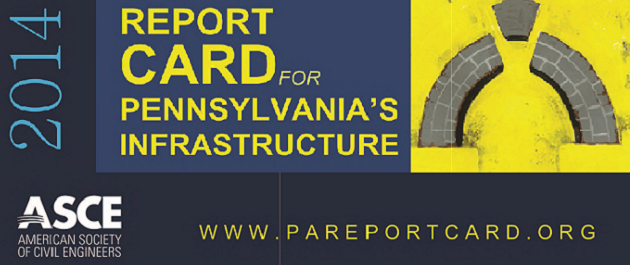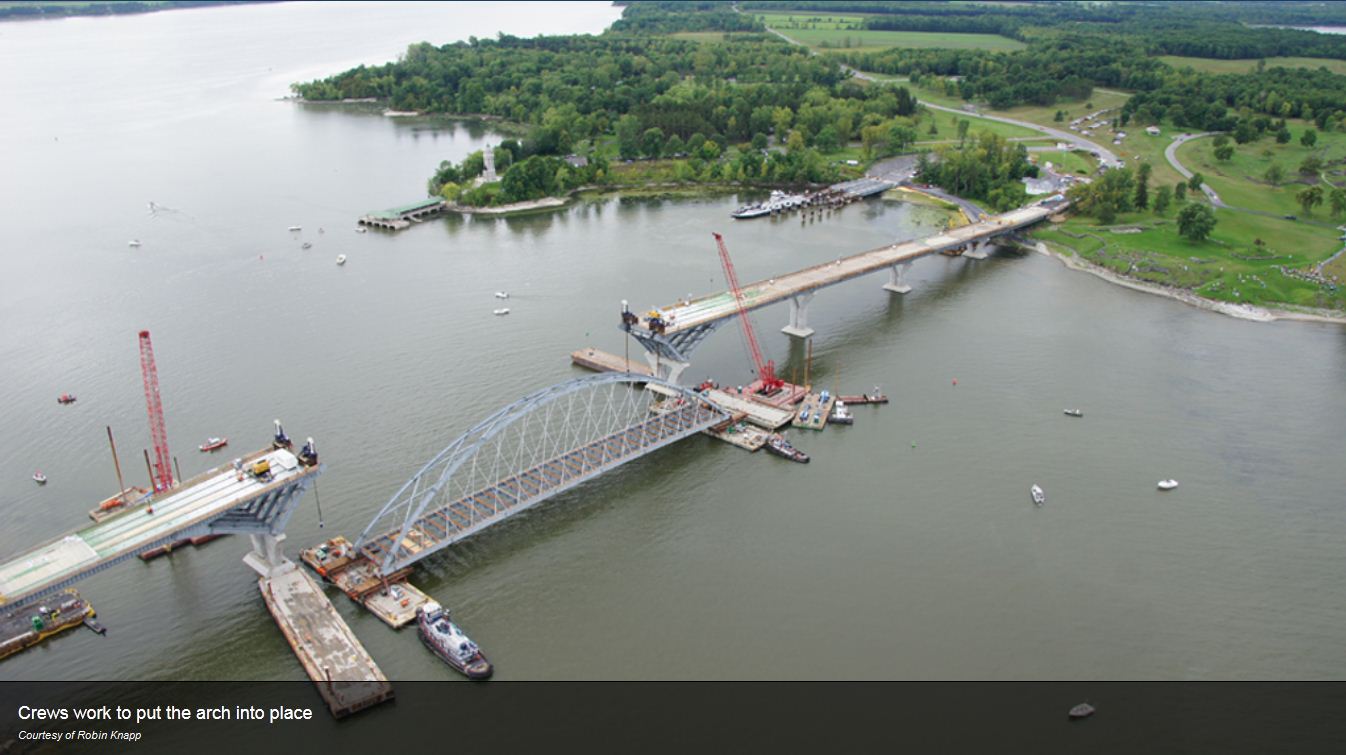Author Archive
Sometimes It's Best to Look Beneath You: A Successful Geothermal Project at Portland International Jetport
July 1st, 2014 | By: Infrastructure Report Card
 Commit to Success
America’s infrastructure needs a national commitment to bring existing infrastructure into a state-of-good-repair, and in the long term we must modernize and build in a targeted and strategic manner. This means leadership at the federal, state, and local levels of government, by businesses and individuals, to communicate the importance of our nation’s infrastructure, to craft innovative solutions that reflect the diverse needs of the nation, and to make the investments the system needs. By employing strategies to use every dollar more efficiently and by deploying creative solutions to infrastructure development such as public–private partnerships, we can implement the right projects on time at the right price.
Airport Finds Sustainable Success Underground
Commit to Success
America’s infrastructure needs a national commitment to bring existing infrastructure into a state-of-good-repair, and in the long term we must modernize and build in a targeted and strategic manner. This means leadership at the federal, state, and local levels of government, by businesses and individuals, to communicate the importance of our nation’s infrastructure, to craft innovative solutions that reflect the diverse needs of the nation, and to make the investments the system needs. By employing strategies to use every dollar more efficiently and by deploying creative solutions to infrastructure development such as public–private partnerships, we can implement the right projects on time at the right price.
Airport Finds Sustainable Success Underground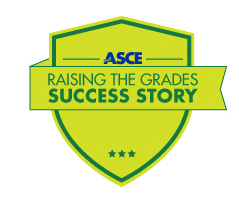 The centerpiece of the Portland International Jetport’s $75 million terminal expansion project was the installation of a geothermal heating and cooling system that reduces operating costs and emissions. A creative first in the airport industry, the $3 million project was able to make use of a $2.5 million Federal Aviation Administration (FAA) Voluntary Airport Low Emissions (VALE) grant.
The system will maintain a constant temperature inside the terminal building by injecting heat into the ground during the summer and taking heat out of the ground during the winter. The system has 23 miles of high-density polyethylene piping and 120 ground wells that reach as deep as 500 feet. The system moves more than 475 gallons of water per minute with a 125 horsepower pump.
The new systems replace an oil-fired system and will save $160,000 in operating costs and prevent the emission of 1,000 tons of carbon per year, promoting both healthier infrastructure and alternative energy.
The centerpiece of the Portland International Jetport’s $75 million terminal expansion project was the installation of a geothermal heating and cooling system that reduces operating costs and emissions. A creative first in the airport industry, the $3 million project was able to make use of a $2.5 million Federal Aviation Administration (FAA) Voluntary Airport Low Emissions (VALE) grant.
The system will maintain a constant temperature inside the terminal building by injecting heat into the ground during the summer and taking heat out of the ground during the winter. The system has 23 miles of high-density polyethylene piping and 120 ground wells that reach as deep as 500 feet. The system moves more than 475 gallons of water per minute with a 125 horsepower pump.
The new systems replace an oil-fired system and will save $160,000 in operating costs and prevent the emission of 1,000 tons of carbon per year, promoting both healthier infrastructure and alternative energy.
Tags: aviation, energy, Maine, report card, success, sustaina
1 Comment »
What They're Saying About the Pennsylvania Report Card
June 30th, 2014 | By: Infrastructure Report Card
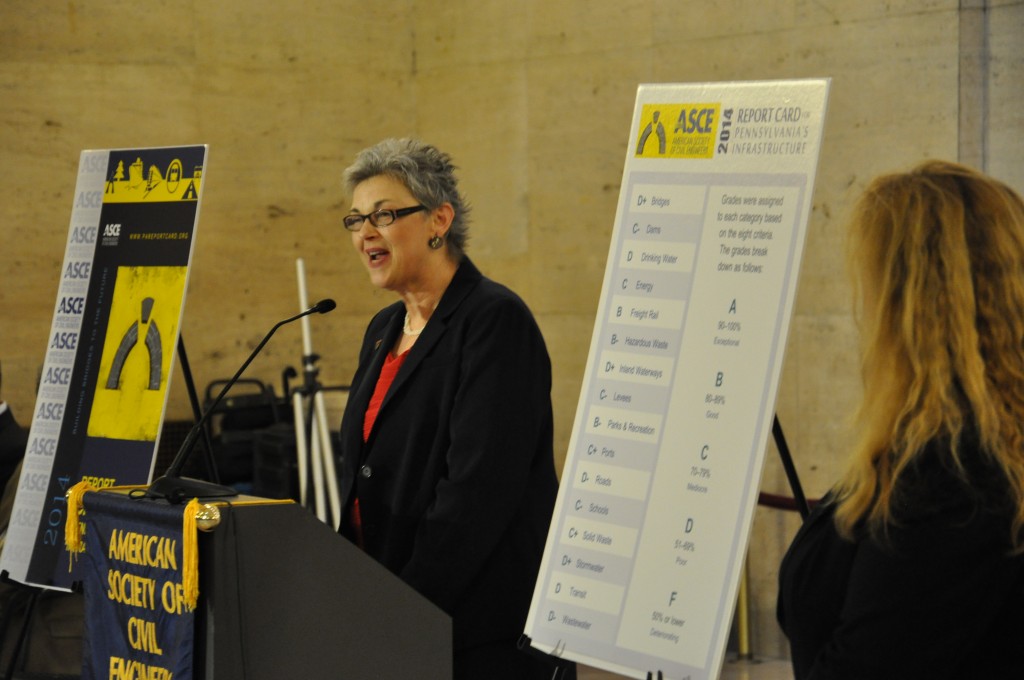 Watch clips from the release events speakers here, courtesy of Urban Engineers.
Watch clips from the release events speakers here, courtesy of Urban Engineers.
- Engineers grade Pa.’s infrastructure: C-minus – Philly.com
- Engineering Group Gives Low Marks to Pennsylvania Infrastructure -CBS Local – Philly
- Pa. Infrastructure Grades Suffer Due To Poor Roads, Bridges – CBS Local – Pittsburgh
- State’s civil engineers give roads a D- in latest “report card” – Pittsburgh Post Gazette
- Pennsylvania earns seven D’s in engineers’ infrastructure report card – The Express-Times
- Pennsylvania’s new infrastructure report card averages to a C minus – Pennlive.com
- Civil engineers give Pennsylvania low marks on infrastructure report card – WFMZ
- State Report Card: Pa. Nearly Fails in Bridges, Water, Roads – NBC 10 Philadelphia
- Pennsylvania’s new infrastructure report card averages to a C minus -The Patriot-News
- Civil engineers: More infrastructure spending is needed – Allentown Morning Call
- Grades not good in engineers’ study of Pa.’s infrastructure – WFMZ Allentown
- Commonwealth infrastructure reaches almost an ‘F’ -FOX43.com
- Report: 1 in 4 PA bridges structurally deficient – Fox 43
- Pennsylvania earns seven D’s in engineers’ infrastructure report card – Lehigh Valley Live
- Pennsylvania gets seven D’s in infrastructure report – Central Penn Business Journal
- Engineers grade Pa.’s infrastructure: C-minus – Bloomberg Businessweek
- State infrastructure gets a C-minus grade – Delaware County Daily Times
- Pa.’s infrastructure barely makes the grade – Newsworks.org
Tags: news, Outreach, Pennsylvania, report card
No Comments »
Pennsylvania Earns 7 Poor D Grades in New Report Card
June 25th, 2014 | By: Infrastructure Report Card
Today, civil engineers from across Pennsylvania released a new Report Card for Pennsylvania’s Infrastructure giving 16 grades for the state’s infrastructure. Here’s how Pennsylvania’s infrastructure ranks from worst grades to best: Roads D- Wastewater D- Drinking Water D Transit D Bridges D+ Inland Waterways D+ Stormwater D+ Dams C- Levees C- Schools C- Energy C Solid Waste C+ Ports C+ Hazardous Waste B- Parks and Rec B- Freight Rail B The Report Card found that Pennsylvania faces immense challenges to maintaining and modernizing infrastructure throughout the state:- Pennsylvania has the highest percentage of structurally deficient bridges in the country. Of the Commonwealth’s more than 22,000 bridges, nearly one in four are considered structurally deficient.
- Pennsylvania has the most combined sewer overflows (CSOs) of any state.
- The Commonwealth must invest $28 billion over the next 20 years to repair existing wastewater systems, meet clean water standards and build or expand existing systems to meet increasing demands
- Pennsylvania’s 1.3 traffic fatalities per 100 million miles of travel is significantly higher than the national average (1.1).
- KEEP UP THE MOMENTUM FOR BETTER INFRASTRUCTURE: In 2013, Pennsylvania’s officials showed leadership by passing a transportation package that will start putting the roads, bridges, and transit systems back into working order.
- AFFIRM PUBLIC SAFETY AS GOVERNMENT’S #1 JOB:Whether it’s repairs to bridges, ensuring safe drinking water, or keeping up on dam safety inspections, public safety must always be the first priority as leaders budget and plan for the future. Ensuring infrastructure is resilient and online 99.9% of the time will keep communities safe and the economy thriving.
- STOP WASTING MONEY BY WAITING: Of the 7 infrastructure categories with D grades, all of these deal with transportation and water systems, and much of the repairs and long-term funding are being short-changed. Waiting will only lead to larger issues that will disrupt lives and cost even more when the bill comes due. Pennsylvania must look at the full cost of decisions and then put savings to use.
Tags: Act-89, grades, momentum, Pennsylvania, report card, states, transportation, water
No Comments »
Will Pennsylvania's Infrastructure Make the Grade?
June 19th, 2014 | By: Infrastructure Report Card
Infrastructure has a direct impact on our lives every day—from the water we drink, to the schools our children attend and to the roads and rails we travel.
Join us for one of ASCE’s release events for the  Wednesday, June 25, 2014
Wednesday, June 25, 2014
- State Senator John Rafferty, Jr., Chairman of Senate Transportation Committee
- Harry Campbell, Pennsylvania Executive Director, Chesapeake Bay Foundation
- Randall Over, ASCE National President
- Jason Bowes, ASCE Central PA Section President
- Darin Gatti, Chief Engineer, Philadelphia Streets Department
- Jeffrey Knueppel, Deputy General Manager, SEPTA
- Lester Toaso, District Executive, PennDOT District 6-0
- Daniel Cessna PE, PennDOT Engineering District 11, District Executive
- Dennis Davin, Allegheny County, Director of Economic Development
- Bill Flanagan, Allegheny Conference on Community Development Executive Vice President, Corporate Relations
- Michael W. Rebert, P.E., PennDOT Engineering District 5, District Executive
- Becky Bradley, Executive Director of the Lehigh Valley Planning Commission
- Aurel Arndt, General Manager, Lehigh County Authority, Allentown, PA
RSVP to reportcard@asce.org
Tags: event, infrastructure, media, Pennsylvania, report card
No Comments »
Watch Live- Big Victory for America's Infrastructure With WRRDA Signing
June 10th, 2014 | By: Infrastructure Report Card
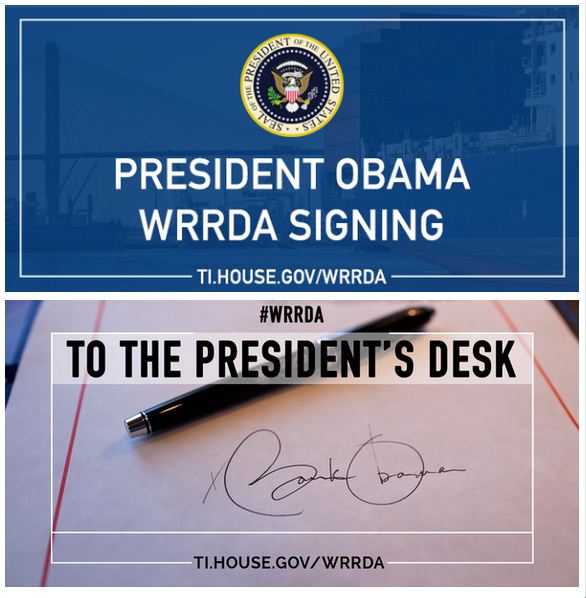 Today, at 10:45am, the White House and members of Congress will hold a signing ceremony for the Water Resources Reform and Development Act (WRRDA).
Today, at 10:45am, the White House and members of Congress will hold a signing ceremony for the Water Resources Reform and Development Act (WRRDA).
New York and Vermont Leadership Make Lake Champlain Bridge Project Success
May 22nd, 2014 | By: Infrastructure Report Card
Commit to Success America’s infrastructure needs a national commitment to bring existing infrastructure into a state-of-good-repair, and in the long term we must modernize and build in a targeted and strategic manner. This means leadership at the federal, state, and local levels of government, by businesses and individuals, to communicate the importance of our nation’s infrastructure, to craft innovative solutions that reflect the diverse needs of the nation, and to make the investments the system needs. By employing strategies to use every dollar more efficiently and by deploying creative solutions to infrastructure development such as public–private partnerships, we can implement the right projects on time at the right price. A Leadership Success StoryIn 2009, civil engineers deemed the Lake Champlain Bridge, connecting Crown Point, New York, to Addison, Vermont, as structurally unsafe, and authorities closed the bridge. By December 2009 it was concluded that the bridge could not be repaired, and the nearly 100-year-old landmark was demolished, removing a key route for area residents.
 Construction began in June 2010 to install a new 2,200 foot long bridge. Despite a harsh winter and spring, construction crews completed the bridge in less than two years, limiting the social and economic impacts. The main arch span was prefabricated off-site, floated by barge to the already constructed approach spans, and then lifted into place. The new bridge also took into account public safety concerns and Complete Streets engineering by including pedestrian and bicycle lanes.
Construction began in June 2010 to install a new 2,200 foot long bridge. Despite a harsh winter and spring, construction crews completed the bridge in less than two years, limiting the social and economic impacts. The main arch span was prefabricated off-site, floated by barge to the already constructed approach spans, and then lifted into place. The new bridge also took into account public safety concerns and Complete Streets engineering by including pedestrian and bicycle lanes.
What Happens To States When the Highway Trust Fund Runs Dry? Florida Weighs In
May 18th, 2014 | By: Infrastructure Report Card
Depletion of the Federal Highway Trust Fund- What Could it Mean for Florida? An Exclusive Interview with FDOT State Secretary Prasad by Steve Lubinski, PE, CWI, LEED-AP Miami-Dade ASCE conducted an exclusive interview on May 6, 2014 with Florida’s Secretary of Transportation and head of FDOT, Ananth Prasad. The Federal Highway Trust Fund (funded by the Federal Gas Tax) provides 30% of Florida Department of Transportation’s funding, but the fund is in danger of becoming insolvent in 3 months or less according to the Congressional Budget Office estimates. Capitol Hill gridlock could make insolvency a reality if they don’t act (as shown in the chart below from USDOT).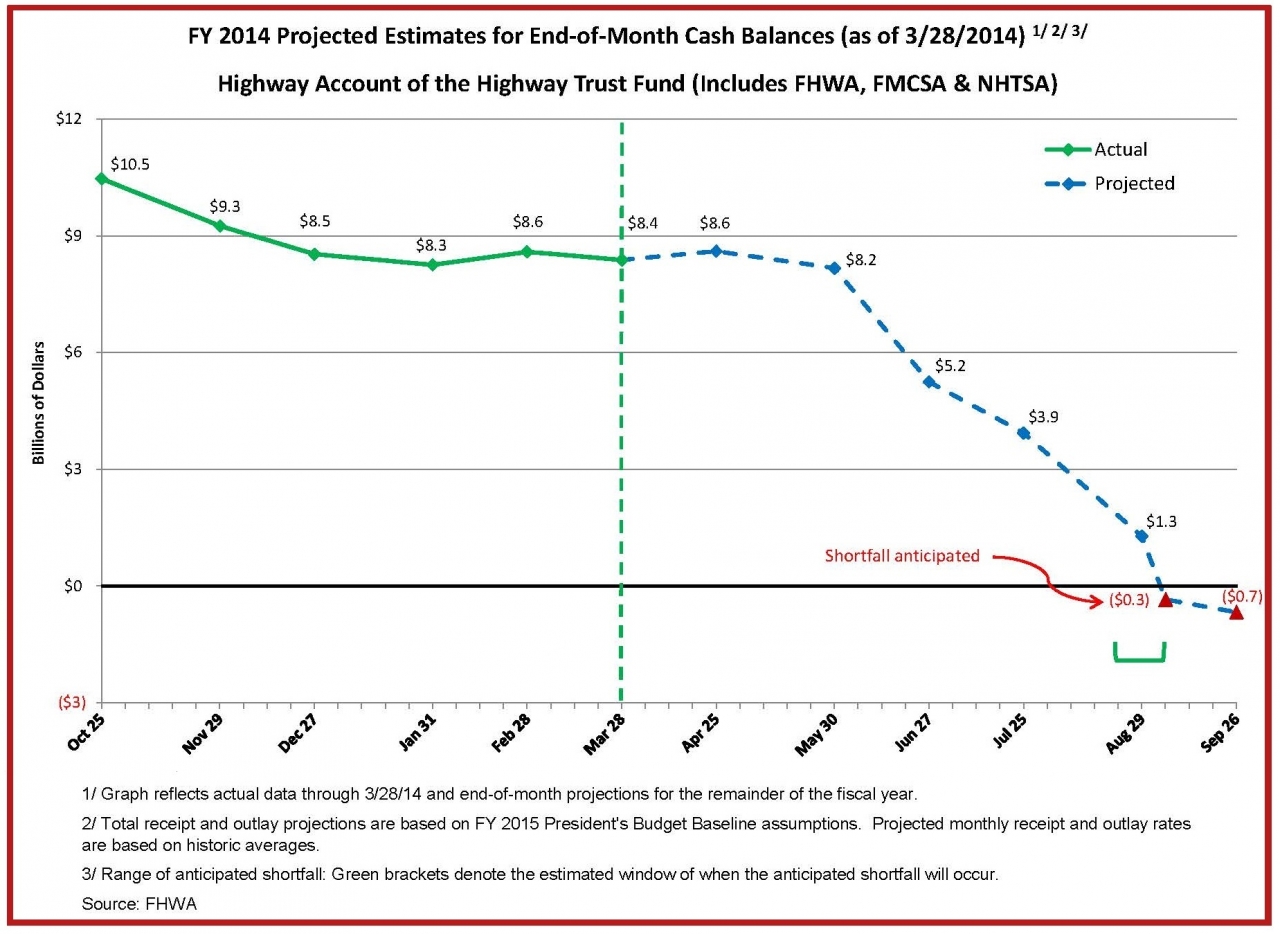 MD-ASCE: Miami-Dade ASCE thanks you for this opportunity. Can you discuss the magnitude of the problem with the Federal Highway Trust Fund?
AP: As you know it’s a problem. The Federal Highway Trust Fund will run out of money in July or August, so Congress will have to find a way to keep it solvent and come up with around $9 Billion. But then the bigger picture going forward is that the receipts coming into the Federal Highway Trust Fund are actually less than the outlays are for project commitments. With all of the projects from state Departments of Transportation the current shortfall would be around $15 Billion next year. First Congress will have to get $9 Billion for the Federal Highway Trust Fund to be solvent for the remainder of this federal fiscal year, and then going beyond, we need to either extend MAP 21 at the current funding level plus add an additional infusion of $15 Billion+ until a more permanent solution is arrived at by having higher revenues to support the program or reduce the program to the level of the revenue.
MD-ASCE: A big reason why the Highway Trust Fund revenues are not keeping pace with our needs is that cars have become much more efficient than 20 years ago. Are there other causes?
AP: Yes. The other issue is that the Federal Highway Gas Tax has not been raised since 1993 or indexed to inflation. When you look at the cars you drove in the mid 1990s, the car that you drive today is more fuel efficient. Also, what a dollar could buy in 1993 is not what a dollar can buy in 2014. So you have two things going against you, the first thing is the purchasing power of the gas tax which hasn’t changed since 1993 (inflation), and the second is your fuel efficiency. Hence we have this crisis that is getting more acute lately because of better fuel efficiency standards.
MD-ASCE: Has FDOT received any correspondence from USDOT about the possible insolvency?
AP: No. However, USDOT Secretary Foxx has made some comments in general briefings with us during federal highway and USDOT national meetings, but no formal correspondence sent out, nor any correspondence about the possibility of slowing down reimbursements to the states. With this federal program, we have to spend money, then seek reimbursement from them (USDOT).
MD-ASCE: Has FDOT begun working on any contingency plans on what to do if the Federal Highway Trust Fund does become insolvent in July or August?
AP: Our contingency plan is that we are only dependent on federal funds to the tune of about 30% of our programs. So, unlike other states as shown in a newspaper article, we are one of the few states that do not have to rely as heavily on federal funds. So what we’ve been doing is carrying a higher balance in our trust fund so that if we don’t get reimbursed (by the federal government) timely, then we can still continue to pay our bills to contractors. I would say that since Florida only relies on the federal government for 30%, and Florida revenues are a little robust, so we carry a higher balance in our Florida trust fund. I think we could survive an insolvent Federal Highway Trust Fund for 3-6 months without any negative impact, but beyond that you’re going to have a tangible impact that you can’t avoid.
MD-ASCE: What do you think will happen in Washington D.C. after July or August?
AP: Beyond July or August there is a big election coming up nationally so I’m cautiously optimistic that they will put more money in to make the fund solvent until next year, then after the fall elections are done the Congress would likely begin debating a much more robust highway bill and how to fund it. Policy frameworks are easy, but the bigger issue is how do you get funding?
MD-ASCE: Has FDOT made any plans for projects that would be protected if the Federal Highway Fund does become insolvent?
AP: Safety and preservation is first. The second thing would be public-private partnership projects. Those have to be protected. So we’ll walk through the list. We have a game plan for doing this. Obviously safety and preservation, then public-private partnerships, then we’ll start looking at projects that could be deferred and projects that are based on other things that are happening in a region that we don’t want to negatively affect.
MD-ASCE: In South Florida we have many big projects planned during this timeframe like the 826-836 interchange, managed lanes for Palmetto and I-75, I-95 Express phase 2.
AP: 826-836 would be one of the last things affected since it is a project already under construction.
MD-ASCE: And the other examples?
AP: The reality is that is that for projects like the express lanes on the Palmetto and I-75 where construction has not begun, we may have to delay the project a few months. But we would not delay an ongoing project of that magnitude like 826-836. We would look at projects that are about to start and maybe push out the start date a little bit, and not take on new projects until the situation stabilizes. Ongoing construction projects…. I don’t foresee that they would be impacted.
MD-ASCE: The USDOT site has a sub-account listed for mass transit, which projected it to remain solvent only until late 2014. How might mass transit be affected?
AP: We would have to look at prioritizing critical services, not taking on new things, and maybe scale back on some things. It’s like if tomorrow someone said you now need to live off only 70% of your income, then you’d have to make some choices. For the next 3 months you need to live off 70% of your income, you’d prioritize, you defer some things.
MD-ASCE: What are some things the public might notice if the federal transit account becomes insolvent?
AP: I’m sure the service levels would be affected. If you don’t have the money, you can’t run the same services….frequency of buses or trains, so you’d see diminished or less frequent service that you’d have to work around. Hopefully they will fix the shortfall. I think right now there is more of a focus (in Washington) on a short-term fix. I don’t believe there is enough support for increasing the gas tax, so the folks in D.C. they may have to look at other options of maybe cutting things that aren’t as relevant in the 21st century.
MD-ASCE: What are some other things you think Floridians should know?
AP: We need to continue investing in infrastructure. At the state level we are doing it. At the federal level their role should be proportionate with the amount of funding they provide. We need to deliver projects in a more cost-efficient way, while making sure we balance it within model impacts, historical impacts, social impacts, and economic considerations. All those things need to be balanced. If we do that, we can deliver projects in the most cost-efficient way.
MD-ASCE: What is your take on the last legislative session in Tallahassee?
AP: Our budget is robust. The legislative session just ended and the legislature just passed the budget to fund the transportation at record levels, which obviously the Governor has been very supportive of….our investment in ports, aviation, and transportation. Investments in transportation are the foundation for economic development and activity. If we are looking to attract businesses to come to the state and wanting businesses in the state to grow, they are going to ask: what’s our quality of life, quality of education, and quality of infrastructure.
Read the full interview here in their May newsletter.
MD-ASCE: Miami-Dade ASCE thanks you for this opportunity. Can you discuss the magnitude of the problem with the Federal Highway Trust Fund?
AP: As you know it’s a problem. The Federal Highway Trust Fund will run out of money in July or August, so Congress will have to find a way to keep it solvent and come up with around $9 Billion. But then the bigger picture going forward is that the receipts coming into the Federal Highway Trust Fund are actually less than the outlays are for project commitments. With all of the projects from state Departments of Transportation the current shortfall would be around $15 Billion next year. First Congress will have to get $9 Billion for the Federal Highway Trust Fund to be solvent for the remainder of this federal fiscal year, and then going beyond, we need to either extend MAP 21 at the current funding level plus add an additional infusion of $15 Billion+ until a more permanent solution is arrived at by having higher revenues to support the program or reduce the program to the level of the revenue.
MD-ASCE: A big reason why the Highway Trust Fund revenues are not keeping pace with our needs is that cars have become much more efficient than 20 years ago. Are there other causes?
AP: Yes. The other issue is that the Federal Highway Gas Tax has not been raised since 1993 or indexed to inflation. When you look at the cars you drove in the mid 1990s, the car that you drive today is more fuel efficient. Also, what a dollar could buy in 1993 is not what a dollar can buy in 2014. So you have two things going against you, the first thing is the purchasing power of the gas tax which hasn’t changed since 1993 (inflation), and the second is your fuel efficiency. Hence we have this crisis that is getting more acute lately because of better fuel efficiency standards.
MD-ASCE: Has FDOT received any correspondence from USDOT about the possible insolvency?
AP: No. However, USDOT Secretary Foxx has made some comments in general briefings with us during federal highway and USDOT national meetings, but no formal correspondence sent out, nor any correspondence about the possibility of slowing down reimbursements to the states. With this federal program, we have to spend money, then seek reimbursement from them (USDOT).
MD-ASCE: Has FDOT begun working on any contingency plans on what to do if the Federal Highway Trust Fund does become insolvent in July or August?
AP: Our contingency plan is that we are only dependent on federal funds to the tune of about 30% of our programs. So, unlike other states as shown in a newspaper article, we are one of the few states that do not have to rely as heavily on federal funds. So what we’ve been doing is carrying a higher balance in our trust fund so that if we don’t get reimbursed (by the federal government) timely, then we can still continue to pay our bills to contractors. I would say that since Florida only relies on the federal government for 30%, and Florida revenues are a little robust, so we carry a higher balance in our Florida trust fund. I think we could survive an insolvent Federal Highway Trust Fund for 3-6 months without any negative impact, but beyond that you’re going to have a tangible impact that you can’t avoid.
MD-ASCE: What do you think will happen in Washington D.C. after July or August?
AP: Beyond July or August there is a big election coming up nationally so I’m cautiously optimistic that they will put more money in to make the fund solvent until next year, then after the fall elections are done the Congress would likely begin debating a much more robust highway bill and how to fund it. Policy frameworks are easy, but the bigger issue is how do you get funding?
MD-ASCE: Has FDOT made any plans for projects that would be protected if the Federal Highway Fund does become insolvent?
AP: Safety and preservation is first. The second thing would be public-private partnership projects. Those have to be protected. So we’ll walk through the list. We have a game plan for doing this. Obviously safety and preservation, then public-private partnerships, then we’ll start looking at projects that could be deferred and projects that are based on other things that are happening in a region that we don’t want to negatively affect.
MD-ASCE: In South Florida we have many big projects planned during this timeframe like the 826-836 interchange, managed lanes for Palmetto and I-75, I-95 Express phase 2.
AP: 826-836 would be one of the last things affected since it is a project already under construction.
MD-ASCE: And the other examples?
AP: The reality is that is that for projects like the express lanes on the Palmetto and I-75 where construction has not begun, we may have to delay the project a few months. But we would not delay an ongoing project of that magnitude like 826-836. We would look at projects that are about to start and maybe push out the start date a little bit, and not take on new projects until the situation stabilizes. Ongoing construction projects…. I don’t foresee that they would be impacted.
MD-ASCE: The USDOT site has a sub-account listed for mass transit, which projected it to remain solvent only until late 2014. How might mass transit be affected?
AP: We would have to look at prioritizing critical services, not taking on new things, and maybe scale back on some things. It’s like if tomorrow someone said you now need to live off only 70% of your income, then you’d have to make some choices. For the next 3 months you need to live off 70% of your income, you’d prioritize, you defer some things.
MD-ASCE: What are some things the public might notice if the federal transit account becomes insolvent?
AP: I’m sure the service levels would be affected. If you don’t have the money, you can’t run the same services….frequency of buses or trains, so you’d see diminished or less frequent service that you’d have to work around. Hopefully they will fix the shortfall. I think right now there is more of a focus (in Washington) on a short-term fix. I don’t believe there is enough support for increasing the gas tax, so the folks in D.C. they may have to look at other options of maybe cutting things that aren’t as relevant in the 21st century.
MD-ASCE: What are some other things you think Floridians should know?
AP: We need to continue investing in infrastructure. At the state level we are doing it. At the federal level their role should be proportionate with the amount of funding they provide. We need to deliver projects in a more cost-efficient way, while making sure we balance it within model impacts, historical impacts, social impacts, and economic considerations. All those things need to be balanced. If we do that, we can deliver projects in the most cost-efficient way.
MD-ASCE: What is your take on the last legislative session in Tallahassee?
AP: Our budget is robust. The legislative session just ended and the legislature just passed the budget to fund the transportation at record levels, which obviously the Governor has been very supportive of….our investment in ports, aviation, and transportation. Investments in transportation are the foundation for economic development and activity. If we are looking to attract businesses to come to the state and wanting businesses in the state to grow, they are going to ask: what’s our quality of life, quality of education, and quality of infrastructure.
Read the full interview here in their May newsletter.
Tags: #fixthetrustfund, congress, economic impact, Florida, highway trust fund, transportation
No Comments »
How Much Would You Owe If Everyone's Infrastructure Bill Came Due?
April 29th, 2014 | By: Infrastructure Report Card
Bloomberg took the opportunity to calculate your infrastructure bill for you based on where you live. See what you would owe for roads, safe drinking water, and airport infrastructure if every one in every state had to pay their bill today.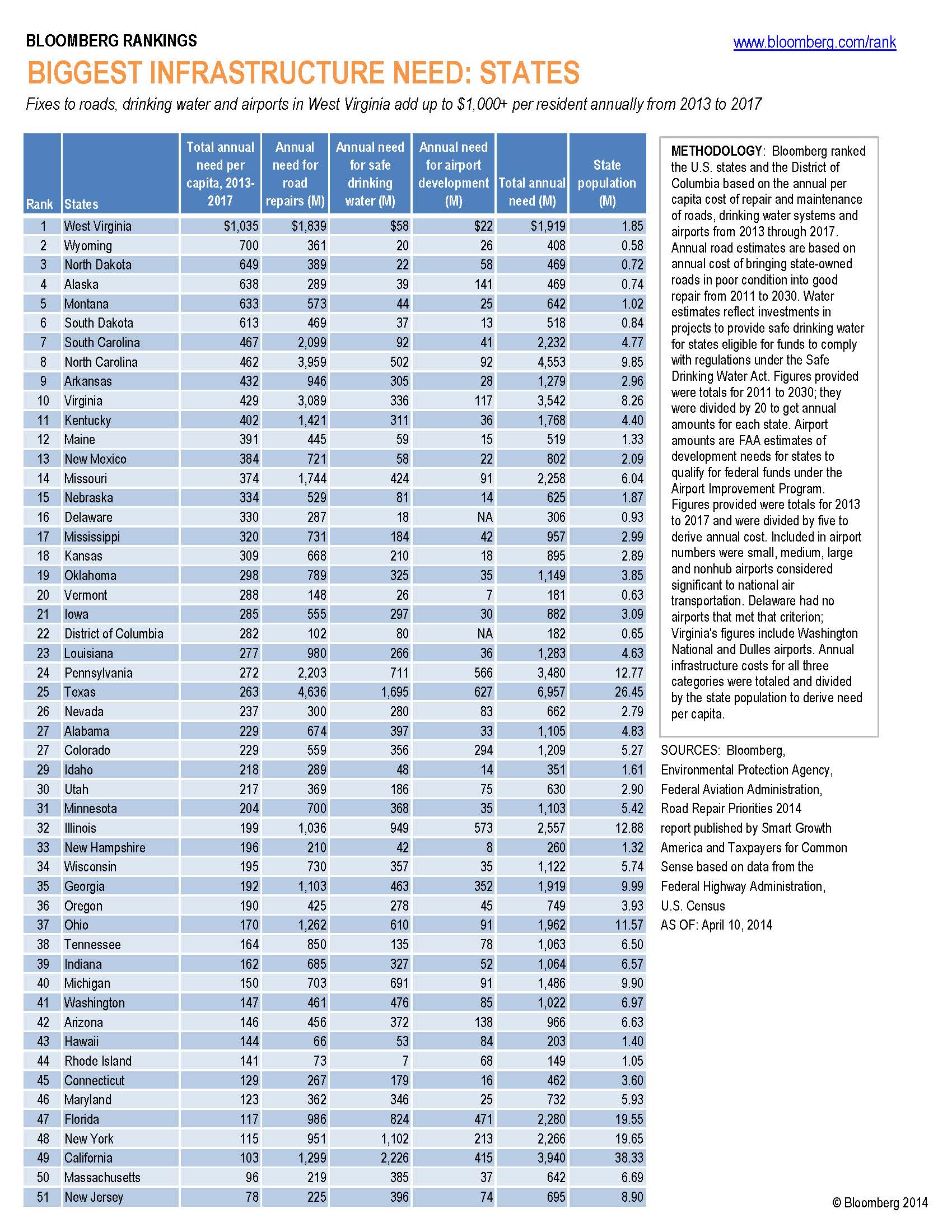
Tags: aviation, bill, infrastructure, rank, roads, water
1 Comment »
Congress Looks to Learn Lessons from Canada’s P3 Experience
April 10th, 2014 | By: Infrastructure Report Card
This week the House Transportation and Infrastructure Committee looked to our northern neighbor Canada for advice on the federal role for public-private partnerships (P3) holding a panel hearing on the International Experience with Public-Private Partnerships, chaired by U.S. Rep. John Duncan (R-TN). Experts from the Canadian financing market were brought in to share their perspective on how their 200+ P3 projects have gone and what they consider to be the best practices of their federal and state framework. Kicking off the discussion, however, was Rep. John Delaney (MD-06) who is sponsoring a bipartisan bill that is gaining support – The Partnership to Build America Act (H.R. 2084) relating directly to P3s. The Partnership to Build America Act would create an infrastructure fund using repatriated corporate earnings and then utilize financing tools like public-private partnerships. The bill has gained the support of 60 House co-sponsors (30 Republicans and 30 Democrats) in the House and a companion, bipartisan Senate bill by Senators Michael Bennet (D-CO) and Roy Blunt (R-MO). If this were passed, it’s estimated that at least 25% of the projects financed with the new fund would use a P3 model. The panel of expert witnesses had many suggestions for what made the Canadian model successful for structuring P3s. However, it was Dr. Larry Blain, Chairman of the Board of Directors, Partnerships British Columbia, who suggested the following four benefits of performance-based infrastructure that should inform the U.S. structure:- Planning discipline and preparation. Performance-based infrastructure projects require comprehensive and long-term definition, costing and risk assessment. Many pitfalls are avoided before a shovel hits the ground.
- Certainty. Projects are on or under budget, and on or ahead of schedule, and key risks are assumed by the private partners. This is a key benefit of performance-based, financially-motivated contracting.
- Life-cycle asset management. In a performance-based approach the private partners have to maintain and rehabilitate the asset over 15-30 years, and they have to leave the asset in the required condition or face financial penalties.
- Efficiencies and innovation. Competition and the profit motive can lead to startling results, where the winning proposal provides solutions that the public owner never contemplated.
Tags: Canada, congress, Delaney, hearing, House, infrastructure, P3, public-private partnership
No Comments »



 */ ?>
*/ ?>




